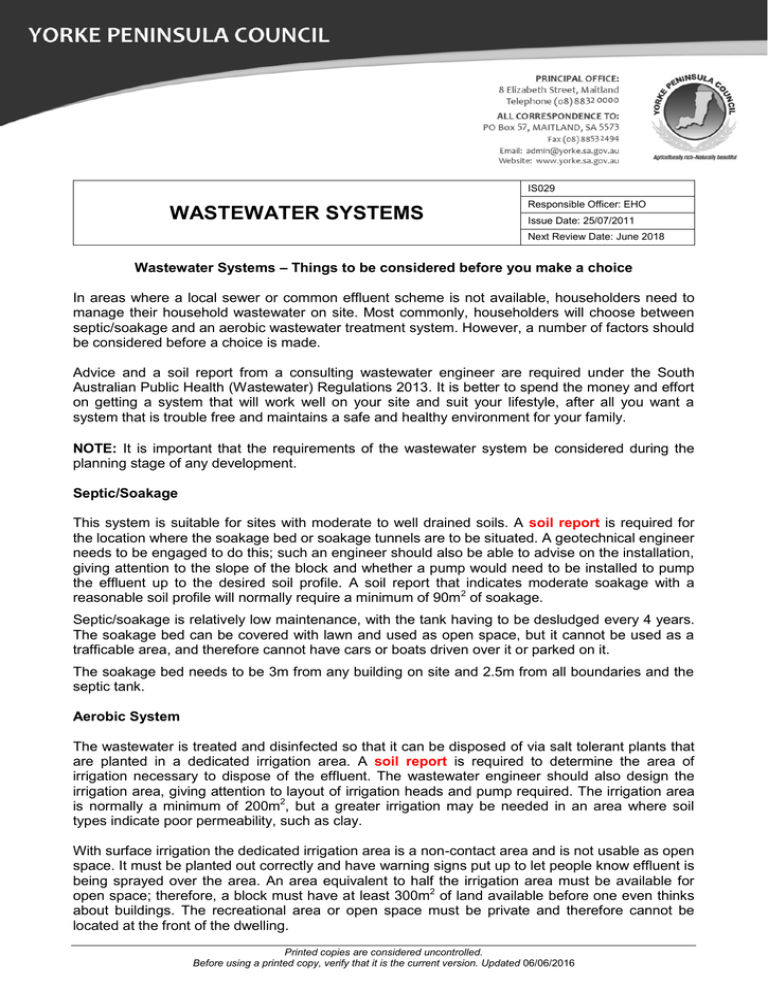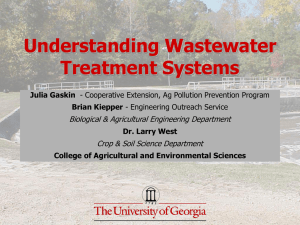IS029 Wastewater Systems - Yorke Peninsula Council
advertisement

IS029 WASTEWATER SYSTEMS Responsible Officer: EHO Issue Date: 25/07/2011 Next Review Date: June 2018 Wastewater Systems – Things to be considered before you make a choice In areas where a local sewer or common effluent scheme is not available, householders need to manage their household wastewater on site. Most commonly, householders will choose between septic/soakage and an aerobic wastewater treatment system. However, a number of factors should be considered before a choice is made. Advice and a soil report from a consulting wastewater engineer are required under the South Australian Public Health (Wastewater) Regulations 2013. It is better to spend the money and effort on getting a system that will work well on your site and suit your lifestyle, after all you want a system that is trouble free and maintains a safe and healthy environment for your family. NOTE: It is important that the requirements of the wastewater system be considered during the planning stage of any development. Septic/Soakage This system is suitable for sites with moderate to well drained soils. A soil report is required for the location where the soakage bed or soakage tunnels are to be situated. A geotechnical engineer needs to be engaged to do this; such an engineer should also be able to advise on the installation, giving attention to the slope of the block and whether a pump would need to be installed to pump the effluent up to the desired soil profile. A soil report that indicates moderate soakage with a reasonable soil profile will normally require a minimum of 90m2 of soakage. Septic/soakage is relatively low maintenance, with the tank having to be desludged every 4 years. The soakage bed can be covered with lawn and used as open space, but it cannot be used as a trafficable area, and therefore cannot have cars or boats driven over it or parked on it. The soakage bed needs to be 3m from any building on site and 2.5m from all boundaries and the septic tank. Aerobic System The wastewater is treated and disinfected so that it can be disposed of via salt tolerant plants that are planted in a dedicated irrigation area. A soil report is required to determine the area of irrigation necessary to dispose of the effluent. The wastewater engineer should also design the irrigation area, giving attention to layout of irrigation heads and pump required. The irrigation area is normally a minimum of 200m2, but a greater irrigation may be needed in an area where soil types indicate poor permeability, such as clay. With surface irrigation the dedicated irrigation area is a non-contact area and is not usable as open space. It must be planted out correctly and have warning signs put up to let people know effluent is being sprayed over the area. An area equivalent to half the irrigation area must be available for open space; therefore, a block must have at least 300m2 of land available before one even thinks about buildings. The recreational area or open space must be private and therefore cannot be located at the front of the dwelling. Printed copies are considered uncontrolled. Before using a printed copy, verify that it is the current version. Updated 06/06/2016 The property owner should discuss with the wastewater engineer the use they will be making of the land area and whether they intend to erect a shed or install a swimming pool at a future date. Because the surface irrigation area removes much of the land space from future development it may be that sub-surface disposal should be considered. Aerobic systems are high maintenance – the system needs to be serviced by a qualified contractor every 3 months and the reports must be submitted to Council. The tank requires chlorine to be dosed into the effluent and a blower needs to operate 24hours a day to provide aeration. The system must have an audible and visual alarm installed to alert the owner to any malfunction of the pump. The irrigation system needs to be installed by a professional irrigation installer/plumber with the plumber provided a Certificate of Compliance at the completion of the job. Alternative Systems Evapo-Transpiration/Absorption/Seepage System (ETA/ETS) – recommended in areas with low permeability soils. System requires planting out with plants that have high uptake of water via transpiration. Wisconsin Mound – often used where a very shallow layer of soil overlays a limiting layer such as rock. Site needs to be relatively flat with environmental conditions that promote evaporation (sunny and good air flow). Depending on the soil classification of the site a mound may require a substantial area of land. Both of the above systems need to be designed and installed by qualified technicians and work best incorporating pressure dosing. They may be more expensive to set up initially but in difficult areas give a better long term option. Holding Tanks Holding tanks are not favoured by Councils due to the high cost of continually having them pumped out. In certain situations, however, they are the only option where: A property is within 100 metres of the high water mark of the coast, and therefore, there is a risk of untreated effluent reaching the marine environment; AND The property has limited space to install an alternative system that would treat the effluent to an acceptable quality for discharge into such a sensitive environmental area. The Application Process A “one size fits all” application form; SF020 On-Site Wastewater System Application, must be completed. Please ensure the owner and applicant (if applicable) sign the application form – the application cannot be processed without the correct signatures. Appropriate fees need to be paid at time of application, please contact Council to establish the fee required for a particular application. All work must be performed by a licensed plumber, the plumber is often the applicant – if the applicant is not the plumber but you know the plumber who will be performing the work this can be made as a notation on the form indicating the licence number of the plumber. Printed copies are considered uncontrolled. Before using a printed copy, verify that it is the current version. Updated 06/06/2016 PLANS REQUIRED TO BE DRAWN AND SUPPLIED WITH APPLICATION (two copies required) Site Layout Plan – Drawn to scale (1:100 or 1:200 typical) including: Block dimensions Contours indicating natural ground fall Proposed location of the building and all other structures (both proposed and existing) including sheds, swimming pools and paving Position of the proposed septic tank, pump sump, distribution sump and effluent disposal system, including distances from boundaries, buildings etc. Details of any site modifications eg. benching, cutting and filling Details of any well, bore or dam used or likely to be used for human and/or domestic use Details of water source used for agricultural, aquaculture or stock purpose Details of any water course, identified on a current 1:50 000 Department of Environment, Water and Natural Resources topographic map, used or likely to be used for human and/or domestic purposes Full details of the disposal system including length, width and depth Depth from surface level to the top of the nominated method of effluent disposal Where connection to a septic tank effluent disposal scheme or local sewer scheme is available (Common Wastewater Management Schemes or CWMS), show the line of drain and the connection point. Details on the connection location and requirements can be obtained from the Council. Building Layout Plan A detailed building layout plan must be provided, drawn to a scale of 1:100, showing: The position and description of all the sanitary fixtures to be connected to the septic tank e.g. water closet pan, basin, bath, shower, laundry trough, washing machine, kitchen sink, dishwasher, food waste disposal unit and spa bath together with its capacity Method of connecting the fixtures to the drainage system – including location of sewer drain, inspection openings and inspection shafts, junctions and bends, size and grade of sewer drain, position and size of traps (sanitary fixture, floor waste and overflow relief gully), vents and waste pipes The intended use of the rooms within the building e.g. bedroom, kitchen, family, office, consulting room, dining, bar etc. For non-residential buildings e.g. offices, shops, hotels, hospitals etc. it is necessary to state the maximum number of persons using the system. NOTE: Applicants should note that where the application or plans show insufficient details, delays in approval may result. Further Information Further information and advice on the installation of wastewater systems may be obtained by contacting Council’s Environmental Health Officer on: Maitland Office (08) 8832 0000 Printed copies are considered uncontrolled. Before using a printed copy, verify that it is the current version. Updated 06/06/2016 The following example plans are not to scale Printed copies are considered uncontrolled. Before using a printed copy, verify that it is the current version. Updated 06/06/2016 Printed copies are considered uncontrolled. Before using a printed copy, verify that it is the current version. Updated 06/06/2016




